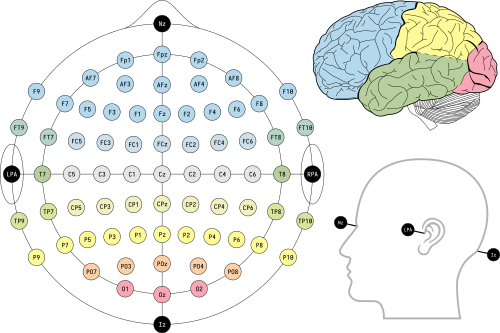The 10-20 system for EEG recording
In order to standardize electrode locations the international 10-20 system is used. It ensures, with a margin of error, that results from various EEG experiments can be compared and reproduced.
Standardizing electrode placement
The '10' and '20' denotes the distances between adjacent electrodes being at 10% or 20% of the total front to back or left to right distance on the skull.
Front to back is measured as the distance between Nasion and Inion. nasion is the clear depressed area between the eyes where the frontal and the nasal bone are connected. Inion is the highest point of the external occipital protuberance in other words, the tip of the bump on the back of your skull.
Left to right can be measured from various structures such as from the preauricular points (LPA, RPA) but is usually the distance from the tip of the ears across the top of the skull.
The Cz location is at the crosspoint halfway the distance from Nasion (Nz) and Inion (Iz) and halfway the tips of the ears.

The 10-20 system
Electrode labels
When higher resolution placements are warranted, the 10-10 system can be used. See picture below.
Each location has letters to identify a lobe of the brain or location.
- Fp: Prefrontal Lobe
- F: Frontal Lobe
- P: Parietal Lobe
- T: Temporal Lobe
- O: Occipital Lobe
- AF: between Fp and F
- FC: between F and C
- FT: between F and T
- CP: between C and P
- TP: between T and P
- PO: between P and O
- A: Mastoid process found just behind the outer ears.
- C: Central, not a lobe but typically used for determining stages of sleep.
In addition, each location has a number, either odd or even.
- Even numbers: Electrode placement on the right side of the brain
- Odd numbers: Electrode placement on the left side of the brain
And then there are the 'Z' locations denoting locations over the midline sagittal plane of the skull

The 10-10 system